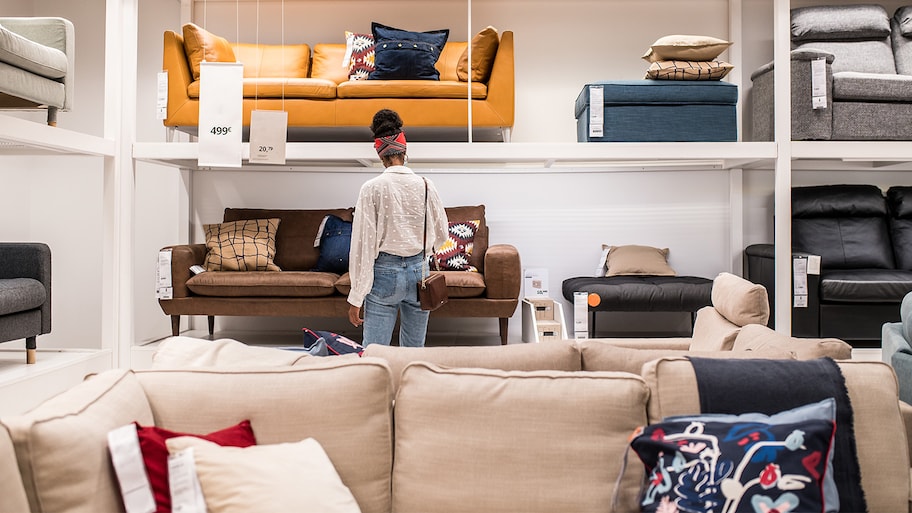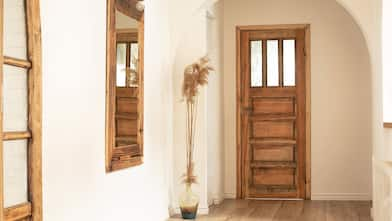When remodeling your home aesthetic, slow and steady wins the race
Decorating your new home is incredibly exciting, so it can be tempting to start purchasing furniture left and right. However, if you don’t make a plan first, you could miss out on ways to make your space that much more beautiful. By following the tips below, you can make your home furniture project as stress-free as possible
1. Set a Budget

Setting a price limit is a great way to narrow your options and have a more organized plan. According to HomeAdvisor, the national average cost to furnish a home is $16,000. However, home furnishing can cost as little as $3,500 and as much as $95,000 on average. Your budget will depend on how much you’re willing to spend and the specific type of furniture you’re purchasing.
For instance, sofas, TV stands, and chairs tend to be pricey, while floor lamps and bookshelves are inexpensive. Look into the average prices of each and land on a reasonable total before purchasing. If you’re struggling to stick to your budget, remember that you don’t have to buy everything right now.
2. Measure Your Spaces

Measuring your room’s dimensions is crucial. You don’t want to purchase the perfect sofa only to find out it’s too big for your living room. Plus, if you try to eyeball the measurements, you may buy furniture that doesn’t fit the space. You’ll ultimately pay more for transportation and delivery costs.
Also, measure your doorways and hallways before bringing in large items. It’s not a great feeling to lug a huge piece of furniture up each step just to find that it doesn’t fit through the doorway. You can also get the dimensions of the entire room and create blueprints and plans for yourself. Use tape to outline the sizes of your furniture to stay organized and create a plan.
3. Prioritize High-Traffic Spaces
Instead of tackling everything at once, start with the high-priority areas used most. For example, if you eat at the dinner table every night, you’ll want to add it to your shopping cart first. The opposite is true of low-use spaces. Sure, you want a cozy guest bedroom, but keep the furniture low on your list if you’re not anticipating visitors for a while.
4. Make a Wish List
Do you want a mattress that will keep you cool? How about a couch that easily flips into a bed? If you have specific asks for your furniture beyond budget and dimensions, make these known to anyone shopping with you. Armed with this knowledge, you can narrow your search and avoid falling in love with pieces that don’t meet your needs.
5. Get Inspiration

Since most of us aren’t interior decorating pros, you may need some decorating help. You can use various tools for inspiration, including social media, magazines, and photos from furniture companies.
You can also turn to other homeowners for inspiration. It’s often helpful to visit another’s home and look at their furniture placement. You may find a new way to style your bedroom—or uncover a layout you want to avoid. Another option is to hire a local interior designer to help you learn what works best for your space.
6. Narrow Down a Color Palette

While each room of your home should look slightly different, it’s better to have a cohesive color palette to accentuate your home’s flow. Think about the overall vibe you want your home’s decor to project and choose a broad color palette.
Most non-professional home decorators find neutrals in the same color family easy to work with. Some keep it simple and choose three colors for the entire house: ceiling, walls, and trim. If any rooms deviate from this in a major way (say, your kids’ rooms or a basement dedicated to a favorite sports team), no worries; personality is important too.
7. Look at Multiple Furniture Styles
You probably don’t know all the furniture types and styles at your fingertips if you’re taking on a home redecoration. For instance, initially, you might want a modern home until some research suggests that antique furniture is perfect for you. From Jacobean to Colonial, there are many options when looking at different furniture styles, and you won’t know what you’ll like until you research.
8. Determine the Furniture Quality You Need
After finding furniture styles that appeal to you, it’s natural to want to buy furniture that fits your aesthetic. However, before spending more than you should, decide which pieces need high-quality construction and which you can get away with lower-quality features. You’ll probably find that your lifestyle and budget will lead you to purchase the right quality grade.
For example, you likely spend a lot of time on your sofa relaxing. Sofas tend to be furniture that buyers splurge on quality construction techniques like hardwood frames, eight-way hand-tied springs, and durable fabric because they want it to last a long time and stay comfortable over the years.
On the other hand, if few people use your guest bedroom, you can save money on furniture because the wear and tear are minimal. DIY composite wood bedside tables and dressers serve the purpose just fine. But, for your bedroom, you’ll want higher-grade solid wood or veneer wood pieces so they can stand the test of time.
Pre-Assembled Furniture
If you’re looking for furniture that requires everyday use from an entire family, it most often makes sense to buy pre-assembled furniture because it’s sturdier and lasts longer. But, if your budget is the top priority and you have the skills, boxed furniture assembled at home can fill in the gaps in your furniture collection. Don’t forget you can contact furniture assembly services near you for help.
9. Go Green
If you’re trying to increase sustainability in your home, consider buying eco-friendly furniture. Furniture created from sustainably harvested or recycled materials is a great first step toward reducing your carbon footprint.
Stay aware of the greenwashing tactics furniture manufacturers use to market their goods. Greenwashing is terminology or labeling used on the packaging or product descriptions that lead buyers to believe a piece is eco-friendly when in reality, it lacks genuine environmentally friendly materials and production.
If sustainability is important to you, research the company and its practices before purchasing. You can review their manufacturing process on websites like Sustainable Furnishings Council or search for the Green Housekeeping Seal of Approval.
10. Look for Vintage or Used Furniture
Buying vintage and used furniture is one of the original tenants of the green movement; ask any college student. Family and friends have passed furniture around for decades, and thrifty shoppers have scoured vintage shops for years.
If you’ve fallen in love with a new but unaffordable piece of furniture, search for something comparable online or in-person in second-hand stores. You might uncover something similar or better. Or, join your local Freecycle or Buy Nothing Groups, where all items are free. Inspect each piece for stains, rips, and pests before bringing it home.
11. Explore Online Furniture Buying Options
There’s satisfaction in purchasing furniture in-store because of the immediate feedback, but brick-and-mortar stores can only hold so much stock. Online shopping has the advantage of seemingly endless inventory and the 24/7 scroll option.
To buy furniture online successfully, shop with a reputable seller. If you’re unfamiliar with the company, ensure they use an encrypted website and have multiple communication methods, like a phone number and a chat feature. They should also have loyal, repeat customers that leave informative reviews about customer service, delivery, and furniture quality.
Read Product Reviews
Customer reviews and pictures are an insight into the quality and characteristics of the product you want to buy. Reviews help you understand details like color, texture, and quality. Sometimes, you can leave a question, and a company representative or fellow purchaser will leave an answer. Take note of the star ratings, but dig into the comments about why it's a one or five-star review. Is it because of the furniture quality or based on delivery experience?
12. Look for Furniture Sales and Ask for Discounts

Regardless if you buy online or in-store, you can count on furniture sales around holidays like President’s Day and Labor Day, but the deepest discounts are usually found in January, February, August, and September because retailers want to move the old stock to bring in the new season’s collections.
If you’re hunting for a deal online, ask for a promo code from a live chat or phone representative. While in-person, ask the associate if the price is negotiable, especially if you’re a repeat customer. In both cases, comparison shopping usually yields a lower price. So, use a price comparison tool like Honey or Google Shopping. You can also ask the manager of a walk-in store if they’ll beat a better price at a competitor location.
Understand In-Store Financing Options
Sometimes furniture stores offer financing options. Typically store financing isn’t the most cost-effective because of high annual percentage rates. The terms and conditions can also be hard to follow and maintain. Any mistake in repayment could be costly, so understand all of the fine print if you apply.
13. Don’t Buy Everything at Once

Like many furniture shoppers, you’ll feel the rush of buying new things early on, but after extensive searching, you might settle for items that are easy to find or more expensive because you’re ready to finish the job. If you try to buy everything at once, you risk buyer’s remorse later.
It takes time to thoughtfully furnish a home that matches your tastes and meets your immediate and long-term needs. So from the start, follow the advice of professional interior designers: only buy what you love. It's helpful to think of furniture shopping as a long-term project and set small purchasing goals along the way.




